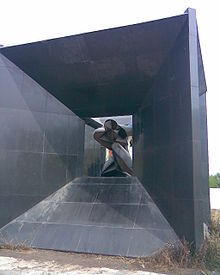- Stalinist repressions in Mongolia
-
The Stalinist repressions in Mongolia had their climax between 1937 and 1939 (Mongolian: Их Хэлмэгдүүлэлт, Ikh Khelmegdüülelt, "Great Repression"), under the leadership of Khorloogiin Choibalsan. The purges affected the whole country, although the main focus was on upper party and government ranks, the army, and especially[citation needed] the Buddhist clergy. One very common accusation was collaboration with supposed pro-Japanese spy rings. The number of people killed in the purges is usually estimated to have been between 22,000[1] and 35,000 people,[2] or about three to four percent of Mongolia's population at that time. Nearly 18,000 victims were Buddhist lamas.[1] Some authors also offer much higher estimates, up to 100,000 victims.[2] The closure of all but one monastery and destruction of all but a few meant that Mongolia's cultural landscape would be changed forever.
The Gandan Monastery in Ulaanbaatar was closed in 1938 at the height of the purges but reopened in 1944. It was the only monastery in Mongolia to remain functioning during the Communist era, and one of the very few that escaped destruction.
Mass graves were investigated in 1991 in Mörön[3], and in 2003 in Ulaanbaatar.[4] The corpses of hundreds of executed lamas and civilians were unearthed, all killed with a shot to the base of the skull.[4]
The "Victims of Political Persecution Museum" in Ulaanbaatar is dedicated to the victims of the purges. It was once the residence of executed Prime Minister Peljidiin Genden. In 1996 his daughter Tserendulam turned it into a museum.[5] One of the exhibits is a row of skulls with bullet holes dating from the time of the purges.[6]
Contents
Notable victims
- Anandyn Amar, prime minister of Mongolia from 1936 to 1939
- Peljidiin Genden, prime minister of Mongolia from 1932 to 1936
- Darizavyn Losol
- Gelegdorjiin Demid
Buryats
A number of prominent Buryats connected to Mongolia were imprisoned and killed during the purges in the Soviet Union, among them:
- Tseveen Jamsrano
- Elbegdorj Rinchino
- Dash Sampilon
- Erdene Batkhaan
See also
References
- ^ a b Christopher Kaplonski, Thirty thousand bullets, in: Historical Injustice and Democratic Transition in Eastern Asia and Northern Europe, London 2002, p.155-168
- ^ a b Twentieth Century Atlas - Death Tolls
- ^ Mass Buddhist Grave Reported in Mongolia The New York Times, October 1991
- ^ a b Mass grave uncovered in Mongolia RTÉ News, Thursday, 12 June 2003
- ^ Memorial Museum of victims of political persecutions
- ^ Lonely Planet.com
External links
- Prelude to Violence: Show trials and state power in 1930s Mongolia by Christopher Kaplonski
- A Forgotten Purge by Timothy May, Department of History, University of Wisconsin–Madison
- The Day of Commemoration, 2011, Ulaanbaatar, Mongolia
Categories:- 20th-century conflicts
- Mongolian People's Republic
- Political and cultural purges
- Democides
Wikimedia Foundation. 2010.


